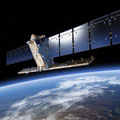Having orbited Earth more than 5300 times while providing radar vision for Europe's Copernicus programme, the Sentinel-1A satellite has completed a successful first year.
The satellite carries an advanced radar to provide an all-weather, day-and-night supply of images of Earth's surface.
Just weeks after its launch from Europe's Spaceport in French Guiana, its imagery was already being used to assist in emergency responses. Some of its first images were crucial in helping authorities in Namibia and the Balkans decide how to respond to a serious floods - both while the satellite was still in its early commissioning phase.
Sentinel-1A began supplying data operationally in October. Within days, experts began using the data to monitor the marine environment. This included the production of ice charts, showing the details of ice conditions in a variety of regions, including the warnings of icebergs drifting in shipping routes to alert vessels.
Over the year, Sentinel-1A has also been used to monitor ice loss from ice caps and ice sheets, such as the Austfonna ice cap in Norway's Svalbard archipelago. The first dedicated campaign observing the Greenland ice sheet was completed in March 2015.
